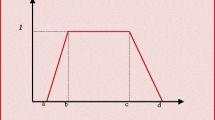Abstract
This paper first presents several formulas for mean chance distributions of triangular fuzzy random variables and their functions, then develops a new class of fuzzy random data envelopment analysis (FRDEA) models with mean chance constraints, in which the inputs and outputs are assumed to be characterized by fuzzy random variables with known possibility and probability distributions. According to the established formulas for the mean chance distributions, we can turn the mean chance constraints into their equivalent stochastic ones. On the other hand, since the objective in the FRDEA model is the expectation about the ratio of the weighted sum of outputs and the weighted sum of inputs for a target decision-making unite (DMU), for general fuzzy random inputs and outputs, we suggest an approximation method to evaluate the objective; and for triangular fuzzy random inputs and outputs, we propose a method to reduce the objective to its equivalent stochastic one. As a consequence, under the assumption that the inputs and the outputs are triangular fuzzy random vectors, the proposed FRDEA model can be reduced to its equivalent stochastic programming one, in which the constraints contain the standard normal distribution function, and the objective is the expectation for a function of the normal random variable. To solve the equivalent stochastic programming model, we design a hybrid algorithm by integrating stochastic simulation and genetic algorithm (GA). Finally, one numerical example is presented to demonstrate the proposed FRDEA modeling idea and the effectiveness of the designed hybrid algorithm.
Similar content being viewed by others
References
Charnes, A., Cooper, W.W., Rhodes, E.: Measuring the efficiency of decision making units. Eur. J. Oper. Res. 6, 429–444 (1978)
Banker, R.D., Charnes, A., Cooper, W.W.: Some models for estimating technical and scale inefficiencies in data envelopment analysis. Manag. Sci. 30, 1078–1092 (1984)
Petersen, N.C.: Data envelopment analysis on a relaxed set of assumptions. Manag. Sci. 36, 305–313 (1990)
Tone, K.: A slack-based measure of efficiency in data envelopment analysis. Eur. J. Oper. Res. 130, 498–509 (2001)
Yu, G., Wei, Q.L., Brockett, P.: A generalized data envelopment analysis model. Ann. Oper. Res. 66, 541–554 (1987)
Cooper, W.W., Seiford, L.M., Tone, K.: Data Envelopment Analysis. Springer Science and Business Media, New York (2007)
Olesen, O.B., Peterso, N.C.: Chance constrained efficiency evaluation. Manag. Sci. 41, 442–457 (1995)
Cooper, W.W., Huang, Z.M., Li, S.X.: Satisfying DEA models under chance constraints. Ann. Oper. Res. 66, 279–295 (1996)
Gong, L., Sun, B.: Efficiency measurement of production operations under uncertainty. Int. J. Prod. Econ. 39, 55–66 (1995)
Cooper, W.W., Huang, Z.M., Lelas, V., Li, S.X., Olesen, O.B.: Chance constrained programming formulations for stochastic characterizations of efficiency and dominance in DEA. J. Prod. Anal. 9, 53–79 (1998)
Huang, Z.M., Li, S.X., Raghavan, V., Sun, D.B.: Proper efficiency and cardinal utilities in multicriteria decision making. Eur. J. Oper. Res. 82, 476–489 (1995)
Retzlaff-Roberts, D.L., Morey, R.C.: A goal programming method of stochastic allocative data envelopment analysis. Eur. J. Oper. Res. 71, 379–397 (1993)
Zadeh, L.A.: Fuzzy sets. Inf. Control 8, 338–353 (1965)
Sengupta, J.K.: A fuzzy systems approach in data envelopment analysis. Comput. Math. Appl. 24, 259–266 (1992)
Hougaard, J.L.: Fuzzy scores of technical efficiency. Eur. J. Oper. Res. 115, 529–541 (1999)
Entani, T., Maeda, Y., Tanaka, H.: Dual models of interval DEA and its extension to interval data. Eur. J. Oper. Res. 136, 32–45 (2002)
Liu, B.: Uncertainty Theory. Springer, Berlin (2004)
Kwakernaak, H.: Fuzzy random variables, I: definitions and theorems. Inf. Sci. 15, 1–29 (1978)
Feng, X., Liu, Y.: Measurability criteria for fuzzy random vectors. Fuzzy Optim. Decis. Mak. 5, 245–253 (2006)
Hao, F., Liu, Y.: Mean-variance models for portfolio selection with fuzzy random returns. J. Appl. Math. Comput. 30, 9–38 (2009)
Wang, S., Watada, J.: Studying distribution functions of fuzzy random variables and its applications to critical value functions. Int. J. Innov. Comput. Inf. Control 5, 279–292 (2009)
Liu, Y., Liu, B.: On minimum-risk problems in fuzzy random decision systems. Comput. Oper. Res. 32, 257–283 (2005)
Liu, Y.: The convergent results about approximating fuzzy random minimum risk problems. Appl. Math. Comput. 205, 608–621 (2008)
Liu, B., Liu, Y.: Expected value of fuzzy variable and fuzzy expected value models. IEEE Trans. Fuzzy Syst. 10, 445–450 (2002)
Liu, Y., Gao, J.: The independence of fuzzy variables with applications to fuzzy random optimization. Int. J. Uncertain. Fuzziness Knowl.-Based Syst. 15, 1–20 (2007)
Liu, Y., Liu, B.: Fuzzy random variable: A scalar expected value operator. Fuzzy Optim. Decis. Mak. 2, 143–160 (2003)
Liu, Y., Liu, Z., Gao, J.: The modes of convergence in the approximation of fuzzy random optimization problems. Soft Comput. 13, 117–125 (2009)
Liu, Y.: The approximation method for two-stage fuzzy random programming with recourse. IEEE Trans. Fuzzy Syst. 15, 1197–1208 (2007)
Liu, Y., Liu, B.: Expected value operator of random fuzzy variable and random fuzzy expected value models. Int. J. Uncertain. Fuzziness Knowl.-Based Syst. 11, 195–215 (2003)
Holland, J.H.: Adaptation in Natural and Artificial Systems. University of Michigan Press, Ann Arbor (1975)
Goldberg, D.E.: Genetic Algorithms in Search, Optimization and Machine Learning. Addison Wesley, Boston (1989)
Author information
Authors and Affiliations
Corresponding author
Rights and permissions
About this article
Cite this article
Qin, R., Liu, YK. A new data envelopment analysis model with fuzzy random inputs and outputs. J. Appl. Math. Comput. 33, 327–356 (2010). https://doi.org/10.1007/s12190-009-0289-7
Received:
Revised:
Published:
Issue Date:
DOI: https://doi.org/10.1007/s12190-009-0289-7




